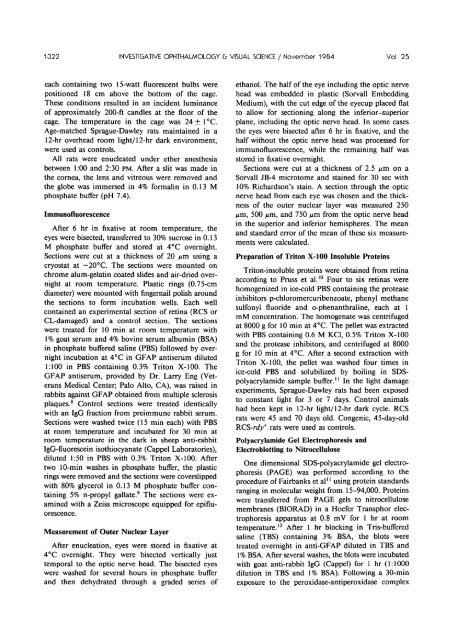Muller Cell Expression of Gliol Fibrillory Acidic Protein offer Genetic ...
Muller Cell Expression of Gliol Fibrillory Acidic Protein offer Genetic ...
Muller Cell Expression of Gliol Fibrillory Acidic Protein offer Genetic ...
Create successful ePaper yourself
Turn your PDF publications into a flip-book with our unique Google optimized e-Paper software.
1322 INVESTIGATIVE OPHTHALMOLOGY b VISUAL SCIENCE / November 1984 Vol. 25<br />
each containing two 15-watt fluorescent bulbs were<br />
positioned 18 cm above the bottom <strong>of</strong> the cage.<br />
These conditions resulted in an incident luminance<br />
<strong>of</strong> approximately 200-ft candles at the floor <strong>of</strong> the<br />
cage. The temperature in the cage was 24 ± 1 °C.<br />
Age-matched Sprague-Dawley rats maintained in a<br />
12-hr overhead room light/ 12-hr dark environment,<br />
were used as controls.<br />
All rats were enucleated under ether anesthesia<br />
between 1:00 and 2:30 PM. After a slit was made in<br />
the cornea, the lens and vitreous were removed and<br />
the globe was immersed in 4% formalin in 0.13 M<br />
phosphate buffer (pH 7.4).<br />
Immun<strong>of</strong>luorescence<br />
After 6 hr in fixative at room temperature, the<br />
eyes were bisected, transferred to 30% sucrose in 0.13<br />
M phosphate buffer and stored at 4°C overnight.<br />
Sections were cut at a thickness <strong>of</strong> 20 nm using a<br />
cryostat at —20°C. The sections were mounted on<br />
chrome alum-gelatin coated slides and air-dried overnight<br />
at room temperature. Plastic rings (0.75-cm<br />
diameter) were mounted with fingernail polish around<br />
the sections to form incubation wells. Each well<br />
contained an experimental section <strong>of</strong> retina (RCS or<br />
CL-damaged) and a control section. The sections<br />
were treated for 10 min at room temperature with<br />
1% goat serum and 4% bovine serum albumin (BSA)<br />
in phosphate buffered saline (PBS) followed by overnight<br />
incubation at 4°C in GFAP antiserum diluted<br />
1:100 in PBS containing 0.3% Triton X-100. The<br />
GFAP antiserum, provided by Dr. Larry Eng (Veterans<br />
Medical Center; Palo Alto, CA), was raised in<br />
rabbits against GFAP obtained from multiple sclerosis<br />
plaques. 8 Control sections were treated identically<br />
with an IgG fraction from preimmune rabbit serum.<br />
Sections were washed twice (15 min each) with PBS<br />
at room temperature and incubated for 30 min at<br />
room temperature in the dark in sheep anti-rabbit<br />
IgG-fluorescein isothiocyanate (Cappel Laboratories),<br />
diluted 1:50 in PBS with 0.3% Triton X-100. After<br />
two 10-min washes in phosphate buffer, the plastic<br />
rings were removed and the sections were coverslipped<br />
with 80% glycerol in 0.13 M phosphate buffer containing<br />
5% n-propyl gallate. 9 The sections were examined<br />
with a Zeiss microscope equipped for epifluorescence.<br />
Measurement <strong>of</strong> Outer Nuclear Layer<br />
After enucleation, eyes were stored in fixative at<br />
4°C overnight. They were bisected vertically just<br />
temporal to the optic nerve head. The bisected eyes<br />
were washed for several hours in phosphate buffer<br />
and then dehydrated through a graded series <strong>of</strong><br />
ethanol. The half <strong>of</strong> the eye including the optic nerve<br />
head was embedded in plastic (Sorvall Embedding<br />
Medium), with the cut edge <strong>of</strong> the eyecup placed flat<br />
to allow for sectioning along the inferior-superior<br />
plane, including the optic nerve head. In some cases<br />
the eyes were bisected after 6 hr in fixative, and the<br />
half without the optic nerve head was processed for<br />
immun<strong>of</strong>luorescence, while the remaining half was<br />
stored in fixative overnight.<br />
Sections were cut at a thickness <strong>of</strong> 2.5 ^m on a<br />
Sorvall JB-4 microtome and stained for 30 sec with<br />
10% Richardson's stain. A section through the optic<br />
nerve head from each eye was chosen and the thickness<br />
<strong>of</strong> the outer nuclear layer was measured 250<br />
ixm, 500 fim, and 750 /xm from the optic nerve head<br />
in the superior and inferior hemispheres. The mean<br />
and standard error <strong>of</strong> the mean <strong>of</strong> these six measurements<br />
were calculated.<br />
Preparation <strong>of</strong> Triton X-100 Insoluble <strong>Protein</strong>s<br />
Triton-insoluble proteins were obtained from retina<br />
according to Pruss et al. 10 Four to six retinas were<br />
homogenized in ice-cold PBS containing the protease<br />
inhibitors p-chloromercuribenzoate, phenyl methane<br />
sulfonyl fluoride and o-phenanthraline, each at 1<br />
raM concentration. The homogenate was centrifuged<br />
at 8000 g for 10 min at 4°C. The pellet was extracted<br />
with PBS containing 0.6 M KC1, 0.5% Triton X-100<br />
and the protease inhibitors, and centrifuged at 8000<br />
g for 10 min at 4°C. After a second extraction with<br />
Triton X-100, the pellet was washed four times in<br />
ice-cold PBS and solubilized by boiling in SDSpolyacrylamide<br />
sample buffer." In the light damage<br />
experiments, Sprague-Dawley rats had been exposed<br />
to constant light for 3 or 7 days. Control animals<br />
had been kept in 12-hr light/12-hr dark cycle. RCS<br />
rats were 45 and 70 days old. Congenic, 45-day-old<br />
^y" 1 " rats were used as controls.<br />
Polyacrylamide Gel Electrophoresis and<br />
Electroblotting to Nitrocellulose<br />
One dimensional SDS-polyacrylamide gel electrophoresis<br />
(PAGE) was performed according to the<br />
procedure <strong>of</strong> Fairbanks et al" using protein standards<br />
ranging in molecular weight from 15-94,000. <strong>Protein</strong>s<br />
were transferred from PAGE gels to nitrocellulose<br />
membranes (BIORAD) in a Hoefer Transphor electrophoresis<br />
apparatus at 0.8 mV for 1 hr at room<br />
temperature. 12 After 1 hr blocking in Tris-buffered<br />
saline (TBS) containing 3% BSA, the blots were<br />
treated overnight in anti-GFAP diluted in TBS and<br />
1% BSA. After several washes, the blots were incubated<br />
with goat anti-rabbit IgG (Cappel) for 1 hr (1:1000<br />
dilution in TBS and 1% BSA). Following a 30-min<br />
exposure to the peroxidase-antiperoxidase complex
















